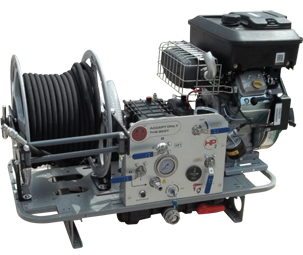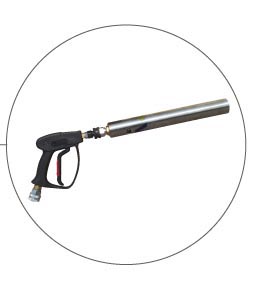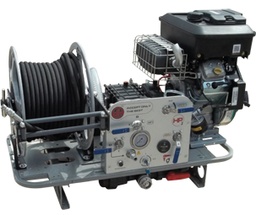- All Products
- Trailers & Skid Units
- Wildland CET High Pressure Skid Unit w/ 200 Gallon Tank & Foam System - Estimate showing, price available on request
Wildland CET High Pressure Skid Unit w/ 200 Gallon Tank & Foam System - Estimate showing, price available on request
Freight and crating is extra

Pumps
Wildland CET High Pressure Skid Unit – Versatile, High-Performance Fire Suppression 🚒
The Wildland CET High Pressure Skid Unit is a powerful, modular firefighting solution designed for efficient water and foam application in wildland and interface fire scenarios. Built to tackle tough environments, this unit combines high-pressure performance with portability, making it an indispensable tool for rapid response teams.
Key Features:
- High-Pressure Pumping:
- Equipped with a CET piston-type high-pressure pump delivering 11 GPM at a formidable 1450 PSI, ensuring effective suppression with minimal water usage.
- Self-priming design enhances operational readiness and ease of use, reducing setup time in critical situations.
- Robust Engine:
- Powered by a 16hp Briggs and Stratton engine with an integrated gas tank for reliable and consistent performance in the field.
- Includes a 1.5-gallon fuel tank, providing ample runtime for extended operations.
- Foam System:
- Integrated high-pressure foam proportioning system for consistent foam application across a range of concentrations, enhancing fire knockdown efficiency and resource conservation.
- Flexible Discharge Options:
- Triple-use discharge gun capable of fog, jet, and atomized spray modes for versatility in various fire conditions and tactical needs.
- Durable Construction:
- High-strength epoxy-treated frame for exceptional durability and rust resistance, ensuring longevity and reliability in harsh environments.
- Comprehensive Hose Setup:
- Includes an electric hose reel with 150 feet of high-pressure hose for extended reach and maneuverability.
- Auxiliary outlet on the control panel allows for the connection of a second line, expanding operational flexibility.
- Modular Design:
- Custom pump panel and modular configuration allow for easy integration and adaptability to specific operational requirements.
- Available with polypropylene water tanks ranging from 50 to 500 gallons, with this unit featuring a 200-gallon tank for balanced capacity and mobility.
Specifications:
- Engine: 16hp Briggs and Stratton
- Pump: CET Piston Type
- Flow Rate: 11 GPM
- Pressure: 1450 PSI
- Tank Capacity: 200 Gallons (Polypropylene)
- Hose Length: 150 feet
- Price: CND 32,260.73 (Freight and crating extra)
Actionable Tips:
- Foam Management: Regularly check and calibrate the foam proportioning system to ensure optimal performance.
- Maintenance: Perform routine maintenance on the engine and pump to prevent downtime and extend the unit's lifespan.
- Training: Ensure personnel are trained on operating the skid unit, focusing on the foam system and discharge gun for effective use in varied conditions.
Alternative Perspectives:
- Water-Only Options: For areas with abundant water supply, a water-only skid might suffice, but foam systems offer superior fire suppression and can be crucial in water-scarce environments.
- Customization: Depending on your operational needs, consider customizing the configuration to include additional accessories or different tank sizes.
Setup and Operation Guide for Wildland CET High Pressure Skid Unit 🚒
Preparation:
- Inspect the Unit:
- Check the engine oil level and fuel tank. Ensure the tank is filled with the appropriate fuel (gasoline for Briggs and Stratton engines).
- Inspect hoses, connections, and the foam proportioning system for any signs of wear or damage.
- Review Safety Protocols:
- Ensure all operators are wearing appropriate personal protective equipment (PPE).
- Familiarize yourself with the engine and pump controls, as well as emergency shut-off procedures.
Setup:
- Position the Unit:
- Place the skid unit in a stable location, ensuring it’s on a level surface to prevent tipping during operation.
- Ensure the unit is accessible for refueling and maintenance but away from direct fire exposure if possible.
- Connect Hoses:
- Attach the high-pressure hose to the discharge outlet using the provided connections.
- Secure the suction hose to the inlet, ensuring the poly foot strainer is submerged in water if drawing from an external source.
- Prepare the Foam System:
- Check the foam concentrate level in the integrated tank.
- Set the foam proportioning system to the desired concentration using the control knob, based on the firefighting requirements.
Operation:
- Start the Engine:
- Follow the engine start-up procedure: turn the fuel valve to "ON," set the choke (if necessary), and pull the starter cord or engage the electric start, if equipped.
- Allow the engine to warm up for a few minutes before engaging the pump.
- Engage the Pump:
- Gradually open the discharge valve while monitoring the pressure gauge to ensure it reaches the desired operating pressure (1450 PSI).
- Adjust the throttle to stabilize the pressure, using the automatic acceleration system to maintain consistent performance.
- Apply Foam or Water:
- Use the triple-use discharge gun to apply foam or water as needed. Adjust the spray pattern (fog, jet, atomized) based on tactical needs.
- Monitor the foam application and adjust the proportioning settings if necessary for optimal coverage and suppression.
Post-Operation:
- Shutdown:
- Gradually close the discharge valve and throttle back the engine to idle.
- Turn off the engine and close the fuel valve.
- Maintenance:
- Drain any remaining water from the tank and hoses to prevent freezing or contamination.
- Clean the unit, focusing on the pump, hoses, and foam system to prevent buildup or corrosion.
- Check and refill any fluids (engine oil, foam concentrate) as needed for the next operation.
Actionable Tips:
- Regularly test the foam system with water to ensure proper function without wasting foam concentrate.
- Keep a log of maintenance activities and any issues encountered to ensure ongoing reliability and performance.
Alternative Perspectives:
- Some users may prefer manual hose reels for simplicity and reduced maintenance, but electric reels offer convenience, especially for frequent deployments.
- Consider pairing the skid unit with additional water storage solutions for extended operations in remote areas.
Foam Concentrate Types and Applications 🌊
1. Class A Foam:
- Description: Designed for wildland and structural fire suppression, Class A foam enhances water penetration and wetting ability, making it ideal for vegetative fuels and building materials.
- Application: Use in wildland firefighting, structural firefighting, and overhaul operations to suppress fire and prevent rekindling.
- Concentration: Typically applied at 0.1% to 1% depending on the scenario and material involved.
2. Class B Foam:
- Description: Used for flammable liquid fires (fuel, oil, etc.), Class B foam forms a film over the liquid surface to suppress vapors and extinguish the fire.
- Application: Effective in industrial settings, fuel depots, and any scenario involving liquid fuel spills.
- Concentration: Usually applied at 3% to 6%, depending on the fuel type and situation.
3. AFFF (Aqueous Film Forming Foam):
- Description: A subtype of Class B, AFFF spreads rapidly across flammable liquid surfaces to form a thin aqueous film, providing quick knockdown.
- Application: Commonly used at airports, refineries, and similar environments where rapid suppression of flammable liquid fires is critical.
- Concentration: Generally used at 3% to 6%.
4. Alcohol-Resistant AFFF:
- Description: This foam is specifically formulated to handle polar solvents (alcohols, ketones) that can break down standard AFFF.
- Application: Ideal for chemical plants and storage facilities where polar solvents are present.
- Concentration: Used at 3% to 6%, with specific instructions based on the foam manufacturer.
Actionable Tips:
- Select the Right Foam: Match the foam type to your operational needs and the most likely fire scenarios you might encounter.
- Regular Testing: Periodically test your foam system with water to ensure it's functional and calibrated without wasting foam concentrate.
- Foam Storage: Store foam concentrates in a cool, dry place to maintain their effectiveness and shelf life.
Alternative Perspectives:
- Some departments may prefer to stock multiple types of foam to cover a wider range of incidents, but this requires careful management of stock and training.
- Environmental considerations are also important; some foams have environmental impacts, so choosing biodegradable or environmentally friendly options can be beneficial.






![[710001527] Wildland CET Econo Pac Bush Buggy Package - Estimate showing, price available on request](https://cdn.wfrfire.com/web/image/product.template/450/image_512/%5B710001527%5D%20Wildland%20CET%20Econo%20Pac%20Bush%20Buggy%20Package%C2%A0-%20Estimate%20showing%2C%20price%20available%20on%20request?unique=dc2412b)
![[710001147] Wildland CET Forest Pac Bush Buggy Package - Estimate showing, price available on request](https://cdn.wfrfire.com/web/image/product.template/451/image_512/%5B710001147%5D%20Wildland%20CET%20Forest%20Pac%20Bush%20Buggy%20Package%C2%A0-%20Estimate%20showing%2C%20price%20available%20on%20request?unique=dc2412b)
![[710001526] Wildland CET Ready Pac Bush Buggy Package - price available on request](https://cdn.wfrfire.com/web/image/product.template/452/image_512/%5B710001526%5D%20Wildland%20CET%20Ready%20Pac%20Bush%20Buggy%20Package%20-%20price%20available%20on%20request?unique=dc2412b)
![[710001037] Wildland CET Skeeter Space Pac Bush Buggy Package -- Estimate showing, price available on request](https://cdn.wfrfire.com/web/image/product.template/453/image_512/%5B710001037%5D%20Wildland%20CET%20Skeeter%20Space%20Pac%20Bush%20Buggy%20Package%20--%20Estimate%20showing%2C%20price%20available%20on%20request?unique=dc2412b)

